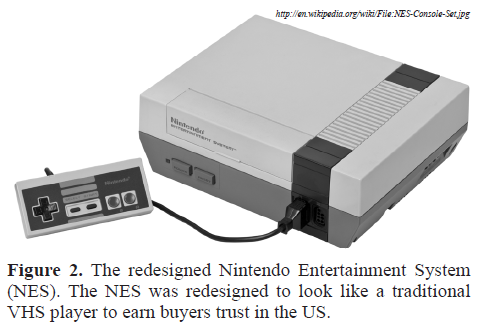 The Nintendo Entertainment System, Nintendo’s first foray into the video game system world outside of Japan, had a long and winding path from concept to execution.
The Nintendo Entertainment System, Nintendo’s first foray into the video game system world outside of Japan, had a long and winding path from concept to execution.
It started life in Japan in 1983 as the Family Computer, commonly shortened to Famicom.
With its red and cream plastic exterior, the Famicom looked relatively toy-like. It was also novel because the controllers were wired directly to the console – no swapping allowed. The system was a huge hit, selling more than 3 million units in Japan in the first 18 months it was on the market.
 The huge success caused Nintendo to turn their eyes to the United States, a much bigger market. However, in 1983, the entire North American video game market had crashed tremendously. Every retailer flat out refused to sell video game consoles. As a result, Nintendo did not want to market such a toy-like device in the United States. So, for the 1985 Consumer Electronics Show, they took the most computer-esque components of the Famicom, such as the keyboard and BASIC cassette writer, gave them and the Famicom a gray coat of paint, and showed these off.
The huge success caused Nintendo to turn their eyes to the United States, a much bigger market. However, in 1983, the entire North American video game market had crashed tremendously. Every retailer flat out refused to sell video game consoles. As a result, Nintendo did not want to market such a toy-like device in the United States. So, for the 1985 Consumer Electronics Show, they took the most computer-esque components of the Famicom, such as the keyboard and BASIC cassette writer, gave them and the Famicom a gray coat of paint, and showed these off.
The reaction was lukewarm.1 Nintendo decided next to try promoting it as an “Entertainment System”, more like a typical consumer electronic. To do so, they intentionally patterned the newly-dubbed Nintendo Entertainment System off of a VHS player, making it a plain, gray box.
They further decided that having cartridges inserted in the top was too reminiscent of older video game consoles. Instead, they went with a “zero insertion force” design, where the cartridge was plugged in on the side then the entire assembly was pushed down.
Due to rampant Famicom piracy in Asia, Nintendo then implemented the first ever regional lockout system. This was implemented in two steps. The first was a physical difference in the cartridges – NES cartridges are bigger than their Famicom counterparts, with a different pinout. The second was on the software level. Special chips in the cartridge and console communicated to each other. If the console chip did not get all the information it expected, then it would refuse to boot the game.
 These design decisions ended up having a large impact on how the NES worked down the road. The regional lockout worked as desired, reducing the amount of piracy significantly. However, unauthorized developers would not be deterred so easily from the potential trove of riches offered by the NES. Tengen, a spin-off of the faltering Atari, was one such developer. They monitored the communication between the chips, trying to reverse engineer the protocol. However, it took longer than management was willing to accept, so Tengen had a lawyer sneak out a copy of the program from copyright documents. Nintendo reacted strongly, suing Tengen[2]. The court sided with Nintendo, validating system lockout techniques.
These design decisions ended up having a large impact on how the NES worked down the road. The regional lockout worked as desired, reducing the amount of piracy significantly. However, unauthorized developers would not be deterred so easily from the potential trove of riches offered by the NES. Tengen, a spin-off of the faltering Atari, was one such developer. They monitored the communication between the chips, trying to reverse engineer the protocol. However, it took longer than management was willing to accept, so Tengen had a lawyer sneak out a copy of the program from copyright documents. Nintendo reacted strongly, suing Tengen[2]. The court sided with Nintendo, validating system lockout techniques.
The pinout difference of the cartridges that was necessary for their system lockout design proved to be significant. The removed pins connected to sound chips that were included in later games, such as Castlevania 3. Removing the pins meant that the NES was cursed to have lower sound quality than the Famicom for such games[3]. Then, as the NES aged, a further flaw was found. The very specific handshake required by the console to boot a cartridge could easily be thwarted by an imperfect electrical connection, which naturally occurred as both cartridge and console got dirty, dusty, or succumbed to moisture. Furthermore, the zero insertion force design was not truly zero insertion force. The orthogonal motions caused the pins of the cartridge to be slightly bent over time, further reducing the contact and making older cartridges even less reliable[4].
Despite these long-term problems, in the short term the design did what was desired. The NES was a smash hit, selling 34 million units in the Americas[5]. It more or less singlehandedly revived the video game industry in North America, and its success was what lured Nintendo’s first competitor, Sega, to enter the market, leading directly to the video game industry we see today. Many of Nintendo’s largest series – the Legend of Zelda and Metroid, to name two examples – originated on the system.
[1] The Ultimate History of Video Games, pg 287
[2] The Ultimate History of Video Games, pg 373
[3] http://www.vintagecomputing.com/index.php/archives/90
[4] www.vintagecomputing.com/index.php/archives/13/nes-s0urgery-replacing-the-cursed-72-pin-connector
[5] http://www.nintendo.co.jp/ir/library/historical_data/pdf/consolidated_sales_e1312.pdf